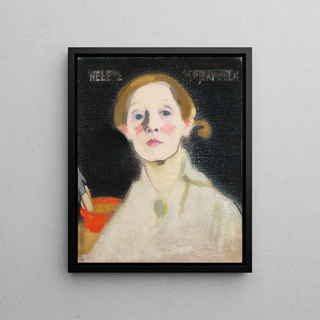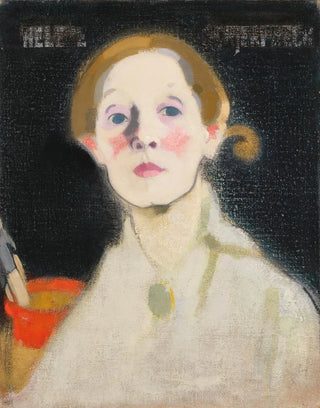Art print | Self-portrait on black background - Helene Schjerfbeck


View from behind

Frame (optional)
Helene Schjerfbeck's black background art print is a work that transcends mere portrait conventions. In this painting, the artist engages in deep introspection, using her own face as a mirror of her soul. The canvas, imbued with an atmosphere that is both mysterious and intimate, invites the viewer to delve into the complex universe of the artist. Schjerfbeck, often regarded as one of the major figures of Finnish art, manages to capture an essence of vulnerability and strength in this self-portrait, which leaves no one indifferent. Every brushstroke seems to resonate with a palpable emotion, revealing layers of a life dedicated to the pursuit of beauty and truth.
Style and uniqueness of the work
Schjerfbeck's style in this art print is characterized by its apparent simplicity, which in reality conceals emotional and psychological depth. The black background, stripped down, highlights the artist's face, emphasizing the nuances of her features and the depth of her gaze. The colors, carefully chosen, oscillate between warm and cool tones, creating a striking contrast that inevitably draws the eye. The painting technique, marked by delicate brushstrokes and particular attention to detail, demonstrates undeniable mastery. Schjerfbeck manages to transcend the simple portrait to offer a reflection on identity and self-perception, a universal theme that resonates across ages.
The artist and her influence
Helene Schjerfbeck, born in 1862, made a mark on the art world with her unique approach and innovative vision. Raised in an artistic environment, she was influenced by Impressionist and Post-Impressionist movements but developed a style that is entirely her own. Her work, often centered on self-portraits and scenes of everyday life, explores themes such as solitude, memory, and the passage of time. Schjerfbeck was also a pioneer in representing femininity, offering an introspective and authentic perspective at a time when women artists were often underrepresented.

Matte finish

View from behind

Frame (optional)
Helene Schjerfbeck's black background art print is a work that transcends mere portrait conventions. In this painting, the artist engages in deep introspection, using her own face as a mirror of her soul. The canvas, imbued with an atmosphere that is both mysterious and intimate, invites the viewer to delve into the complex universe of the artist. Schjerfbeck, often regarded as one of the major figures of Finnish art, manages to capture an essence of vulnerability and strength in this self-portrait, which leaves no one indifferent. Every brushstroke seems to resonate with a palpable emotion, revealing layers of a life dedicated to the pursuit of beauty and truth.
Style and uniqueness of the work
Schjerfbeck's style in this art print is characterized by its apparent simplicity, which in reality conceals emotional and psychological depth. The black background, stripped down, highlights the artist's face, emphasizing the nuances of her features and the depth of her gaze. The colors, carefully chosen, oscillate between warm and cool tones, creating a striking contrast that inevitably draws the eye. The painting technique, marked by delicate brushstrokes and particular attention to detail, demonstrates undeniable mastery. Schjerfbeck manages to transcend the simple portrait to offer a reflection on identity and self-perception, a universal theme that resonates across ages.
The artist and her influence
Helene Schjerfbeck, born in 1862, made a mark on the art world with her unique approach and innovative vision. Raised in an artistic environment, she was influenced by Impressionist and Post-Impressionist movements but developed a style that is entirely her own. Her work, often centered on self-portraits and scenes of everyday life, explores themes such as solitude, memory, and the passage of time. Schjerfbeck was also a pioneer in representing femininity, offering an introspective and authentic perspective at a time when women artists were often underrepresented.






